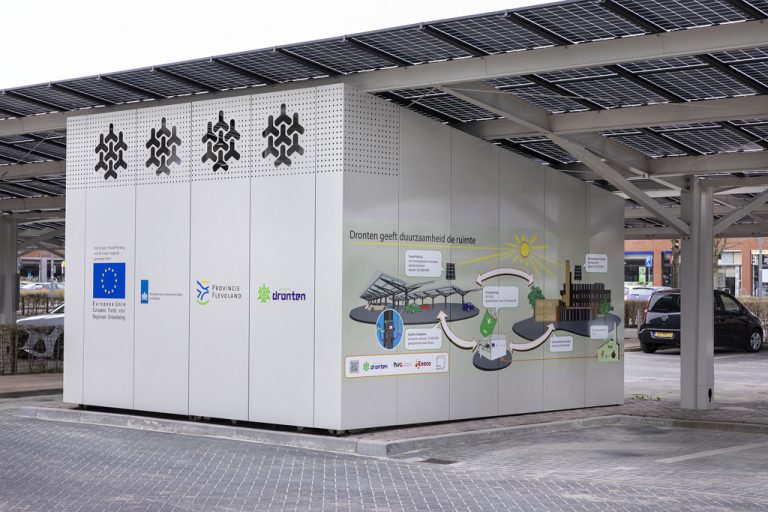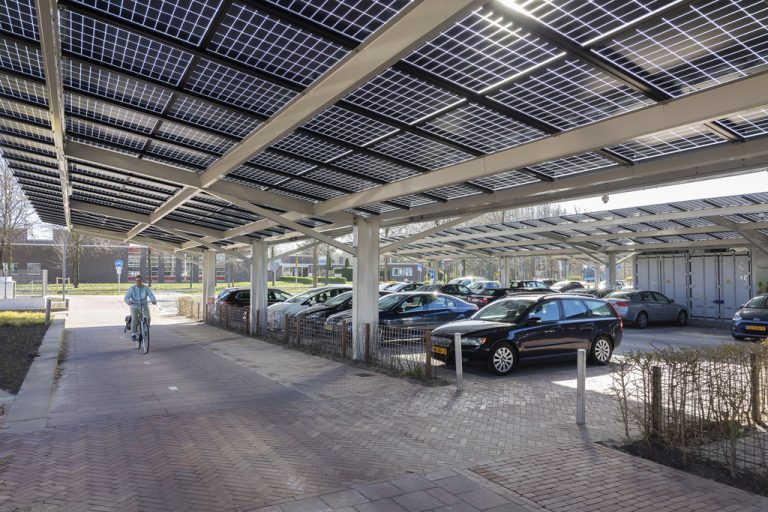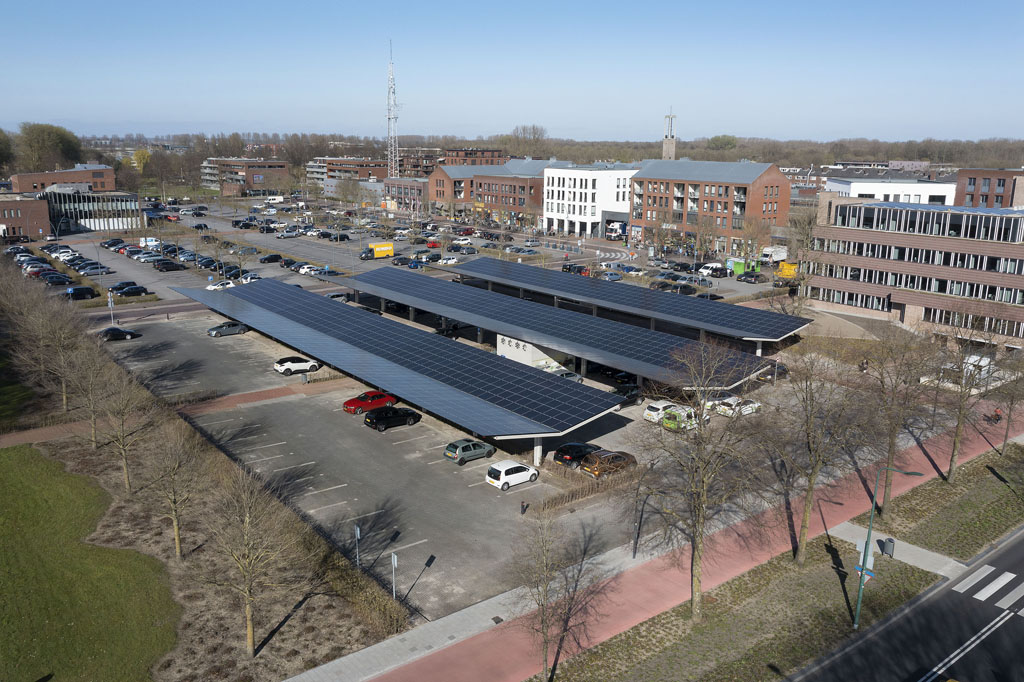The office of the future is located in the polder town of Dronten. Its town hall uses the solar power from the car park to become energy neutral. This is how it works.
De zonnepanelen boven de parkeerplaats moeten het gemeentehuis energieneutraal maken. (Foto: Fotostudio Wierd)
“Do you know this clip about the lonely nut and the crowd?” said Eneco business developer Jasper Feuth. “I was the lonely nut, endlessly droning on about how solar car parks could power their environment. But no one listened. Until now.” Although the SolarParking Dronten has nine project parties, including TU Delft, plus four funders, for Feuth the realisation of a solar car park feels like a personal victory. This project may show how covering a car park with solar panels makes an office building gas free and energy neutral.
Energy flows
The office in this case is the Dronten town hall, which has undergone a thorough renovation of the building and the heating, ventilation and air conditioning system. Strongly improved insulation has reduced the energy consumption for heating, which can now be provided by two heat pumps instead of gas-fired heating. The energy supply has become all-electric. Like all offices, the town hall lacks the space for enough solar panels. Its roof fits about 110 kWp (kilo watt peak, the maximum power). Another 400 kWp comes from solar panels on the car park, the SolarParking.


The charging stations are solar-powered. (Photo: Fotostudio Wierd)
The price for double-faced solar panels has come down considerably, says Feuth. Nonetheless, the project was only feasible after multiple subsidies. The regular pattern of small PV units held between sheets of glass creates pleasing shadows on the cars and the parking deck. Of the parking places, 120 have been covered, 16 of which provide charging for electric cars: four charging stations with four sockets each. There is also a large nickel metal hydride battery with the capacity for four Teslas (350 kWh). An intelligent energy management system optimises the energy flows and energy trade.
The dimensions of the solar systems are such that the town hall ensemble and the charging of the cars average out to energy-neutral over a year. In the summer, it produces more power than it consumes and in the winter it’s vice versa.


An energy unit houses the power electronics and the stationary battery. (Photo: Fotostudio Wierd)
Solar energy is first spent on charging electric vehicles, next on the heat pumps for heating or cooling the town hall. Excess energy is stored in the stationary battery or fed into the grid. Conversely, if there is insufficient solar power, the system will first drain the battery, and only then draw from the grid.
The charging speed for civil servants is slower
Interestingly, there is a difference in charging characteristics for civil servants who work in the town hall and visitors. The charging speed for the former is slower, because the system assumes they won’t come back before 17:00. Such differentiated charging is a prelude for what may lie ahead in automotive charging strategies.
Research
Solar power may be regarded as carbon-free energy, but what about a solar system that exchanges power with the grid? Master student sustainable energy technologies Kaja Tegtmeier will model the entire electric system to calculate how much CO2 emissions are saved by replacing the largely fossil power from the grid with solar power from the car park. The fact that the carbon-intensity on the grid (grammes CO2 equivalent/kWh) varies due to the changing mix of power sources, complicates her calculations.


Energy flows in unscheduled charging (above) and in perfect balance (below). Note how in the lower graph solar production and car charging are in perfect balance. (Graphics: Rishabh Ghotge)
Solar energy and electric vehicles can be a perfect pair if peaks in solar power production are stored in car batteries. If poorly managed, simultaneously charging electric cars may overload the power grid. The same applies to large amounts of solar power directly fed into the grid. But use the peaks in solar power to charge the batteries, and the load on the grid becomes more stable and, more importantly, loses its peaks. These peaks are what causes overloads and blackouts. A smart strategy for combining solar energy and planned charging was developed by researchers in Professor Ad van Wijk’s group at the 3mE Faculty. Rishabh Ghotge is one of them. He tested the optimised scheduling of charging two electric vehicles with solar energy in The Green Village. Ghotge is now also involved in the much larger set-up at the SolarParking Dronten, one of the few places in the Netherlands where solar energy and electric vehicles are combined on a larger scale of 400 kW and 16 cars. (A charging electric car typically draws 10-20 kW).


Societal acceptance of the SolarParking is key to the larger roll-out of the concept. (Photo: Fotostudio Wierd)
Acceptability
Business developer Jasper Feuth is anxious to know how SolarParking will work in practice. How will the battery be used? Can it make money by storing cheap power and selling it when the price is high? Will solar charging work out well in practice? Will it bring down peaks in the grid load as expected? Will the town hall be energy neutral on average over a year? And most important of all: what is the level of societal acceptance for solar carports at this large scale? And how can it be improved?
Societal acceptance of the SolarParking is key to the larger roll-out of the concept to Flevo Airport and its business park. “At first, some people opposed the idea of solar carports at car parks. They feared a massive construction with a huge surface of solar panels,” says Feuth. But the elegant construction with semi-transparent double-faced panels has changed their perception.
Feuth believes that he won’t be the only ‘nut’ singing the praise of large-scale solar car parks. He expects that, like the lonely nut and the crowd, there will be many ‘followers’. Feuth mentions two other parking areas, at Mac3PARK offices in Lelystad and Almere, which are under development.
- The SolarParking in Dronten will be officially opened on Wednesday 14 April 2021. The energy flows will be monitored for a year, and the offset emissions will be calculated after which the concept will be evaluated.
- Watch Leadership from a dancing guy about the lonely nut and the crowd on Youtube
- Project partners are the Province Flevoland, municipality of Dronten, Lelystad Airport, Schiphol Nederland B.V., Ontwikkeling Maatschappij Airport Lelystad Almere (OMALA), TU Delft, Pontis Engineering, Eneco and Alfen
- The SolarParking Dronten project was funded by the European Fund for Regional Development (EFRO), the Dutch Ministry of Economic Affairs and Climate, Province of Flevoland and Dronten municipality.
Do you have a question or comment about this article?
j.w.wassink@tudelft.nl


Comments are closed.